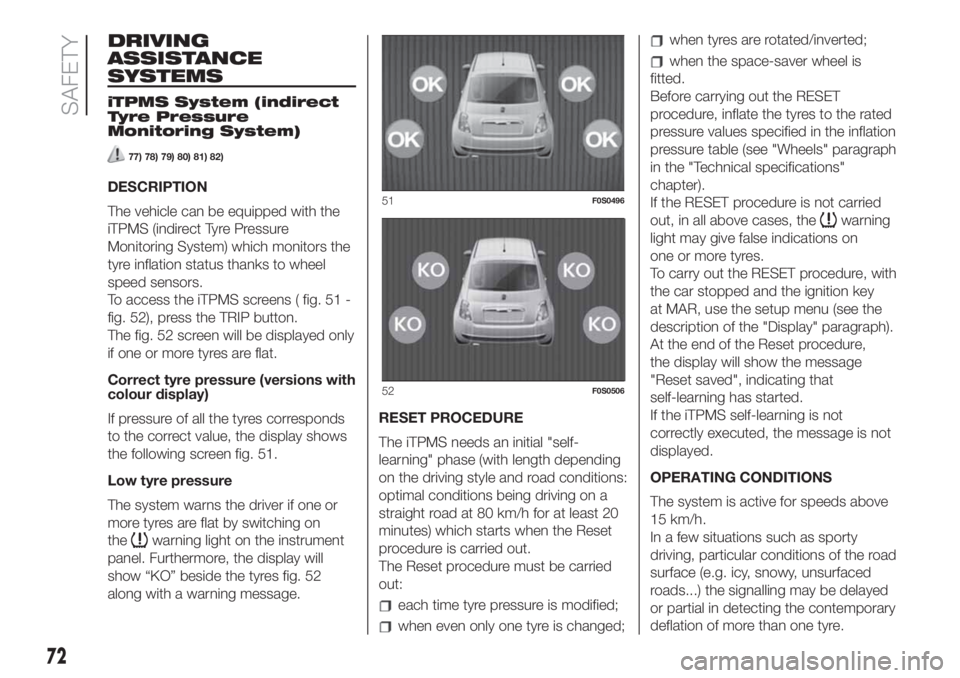length FIAT 500 2020 Owner handbook (in English)
[x] Cancel search | Manufacturer: FIAT, Model Year: 2020, Model line: 500, Model: FIAT 500 2020Pages: 228, PDF Size: 6.01 MB
Page 16 of 228

Backrest angle
adjustment
Turn knob C fig. 10.
Height adjustment
(for versions/markets, where provided)
Operate lever B fig. 11 to lift or lower
the rear part of the cushion to achieve
the most comfortable driving position.Reclining the backrest
10)
4)
To fold the backrest over, adjust lever D
fig. 12 (movement 1) and push the
backrest forwards until it locks
(movement 2).
Then release lever D and, pushing on
the backrest, slide the seat forward
(movement 3).
Driver side and passenger side,
with position memory
(for versions/markets, where provided)
To bring back the seat in its initial
position proceed as follows:
slide the seat backwards pushing on
the backrest, until the seat is locked
(movement 4);
adjust lever D fig. 12 (movement 5);
raise the backrest (movement 6) until
you hear the lock click.IMPORTANT Using lever D fig. 12
before locking the seat in its initial
position will cause the initial seat
position to be lost. In this case the
position of the seat must be restored
through lengthwise adjustment lever A
fig. 9.
Passenger side without position
memory
To bring back the seat in its initial
position proceed as follows:
slide the seat backwards pushing on
the backrest to the desired position
(movement 4);
adjust lever D fig. 12 (movement 5);
raise the backrest (movement 6) until
you hear the lock click.
The type of reattachment manoeuvre
has been chosen to guarantee the
safety of the occupant.
If an obstacle is present (e.g. a bag)
and the seat cannot be returned to its
original position, the mechanism
reattaches the seat only positioning the
backrest to ensure that the seat is
correctly attached to its guides.
10F0S0014
11F0S0015
12F0S0154
14
KNOWING YOUR CAR
Page 74 of 228

DRIVING
ASSISTANCE
SYSTEMS
iTPMS System (indirect
Tyre Pressure
Monitoring System)
77) 78) 79) 80) 81) 82)
DESCRIPTION
The vehicle can be equipped with the
iTPMS (indirect Tyre Pressure
Monitoring System) which monitors the
tyre inflation status thanks to wheel
speed sensors.
To access the iTPMS screens ( fig. 51 -
fig. 52), press the TRIP button.
The fig. 52 screen will be displayed only
if one or more tyres are flat.
Correct tyre pressure (versions with
colour display)
If pressure of all the tyres corresponds
to the correct value, the display shows
the following screen fig. 51.
Low tyre pressure
The system warns the driver if one or
more tyres are flat by switching on
the
warning light on the instrument
panel. Furthermore, the display will
show “KO” beside the tyres fig. 52
along with a warning message.RESET PROCEDURE
The iTPMS needs an initial "self-
learning" phase (with length depending
on the driving style and road conditions:
optimal conditions being driving on a
straight road at 80 km/h for at least 20
minutes) which starts when the Reset
procedure is carried out.
The Reset procedure must be carried
out:
each time tyre pressure is modified;
when even only one tyre is changed;
when tyres are rotated/inverted;
when the space-saver wheel is
fitted.
Before carrying out the RESET
procedure, inflate the tyres to the rated
pressure values specified in the inflation
pressure table (see "Wheels" paragraph
in the "Technical specifications"
chapter).
If the RESET procedure is not carried
out, in all above cases, the
warning
light may give false indications on
one or more tyres.
To carry out the RESET procedure, with
the car stopped and the ignition key
at MAR, use the setup menu (see the
description of the "Display" paragraph).
At the end of the Reset procedure,
the display will show the message
"Reset saved", indicating that
self-learning has started.
If the iTPMS self-learning is not
correctly executed, the message is not
displayed.
OPERATING CONDITIONS
The system is active for speeds above
15 km/h.
In a few situations such as sporty
driving, particular conditions of the road
surface (e.g. icy, snowy, unsurfaced
roads...) the signalling may be delayed
or partial in detecting the contemporary
deflation of more than one tyre.
51F0S0496
52F0S0506
72
SAFETY